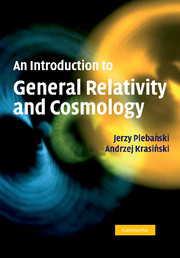Book contents
- Frontmatter
- Contents
- List of figures
- The scope of this text
- Acknowledgements
- 1 How the theory of relativity came into being (a brief historical sketch)
- Part I Elements of differential geometry
- 2 A short sketch of 2-dimensional differential geometry
- 3 Tensors, tensor densities
- 4 Covariant derivatives
- 5 Parallel transport and geodesic lines
- 6 The curvature of a manifold; flat manifolds
- 7 Riemannian geometry
- 8 Symmetries of Riemann spaces, invariance of tensors
- 9 Methods to calculate the curvature quickly – Cartan forms and algebraic computer programs
- 10 The spatially homogeneous Bianchi type spacetimes
- 11 * The Petrov classification by the spinor method
- Part II The theory of gravitation
- References
- Index
3 - Tensors, tensor densities
Published online by Cambridge University Press: 01 March 2010
- Frontmatter
- Contents
- List of figures
- The scope of this text
- Acknowledgements
- 1 How the theory of relativity came into being (a brief historical sketch)
- Part I Elements of differential geometry
- 2 A short sketch of 2-dimensional differential geometry
- 3 Tensors, tensor densities
- 4 Covariant derivatives
- 5 Parallel transport and geodesic lines
- 6 The curvature of a manifold; flat manifolds
- 7 Riemannian geometry
- 8 Symmetries of Riemann spaces, invariance of tensors
- 9 Methods to calculate the curvature quickly – Cartan forms and algebraic computer programs
- 10 The spatially homogeneous Bianchi type spacetimes
- 11 * The Petrov classification by the spinor method
- Part II The theory of gravitation
- References
- Index
Summary
What are tensors good for?
In Newtonian physics, a preferred class of reference systems is used. They are the inertial systems – those in which the three Newtonian principles of dynamics hold true. However, it may be difficult in practice to identify the inertial systems. As we have seen in Chapter 1, the inertial force imitates the gravitational force, so it may not be easy to make sure whether a given object moves with acceleration or remains at rest in a gravitational field. Hence, the laws of physics should be formulated in such a way that no reference system is privileged. The choice of a reference system, even when it is evidently convenient (e.g. the centre of mass system), is an act of human will, while the laws of physics should not depend on our decisions.
Tensors are objects defined so that no reference system is privileged. For the beginning, we will settle for a vague definition that we will make precise later. Suppose we change the coordinate system in an n-dimensional space from {xα}, α = 1, 2, …, n to, α′ = 1, 2, …, n. A tensor is a collection of functions on that space that changes in a specific way under such a coordinate transformation. The appropriate class of spaces and the ‘specific way’ in which the functions change will be defined in subsequent sections.
Differentiable manifolds
As already stated, in relativity we will be using non-Euclidean spaces. The most general class of spaces that we will consider are differentiable manifolds. This is a generalisation of the notion of a curved surface for which a tangent plane exists at every point of it.
- Type
- Chapter
- Information
- An Introduction to General Relativity and Cosmology , pp. 13 - 25Publisher: Cambridge University PressPrint publication year: 2006

